
 KNITTING SOCKS
KNITTING SOCKS
FROM AROUND
THE WORLD  Kari Cornell, Editor Photography by
Kari Cornell, Editor Photography by
Sue Flanders and Janine Kosel  First published in 2011 by Voyageur Press, an imprint of MBI Publishing Company, 400 First Avenue North, Suite 300,
First published in 2011 by Voyageur Press, an imprint of MBI Publishing Company, 400 First Avenue North, Suite 300,
Minneapolis, MN 55401 USA Copyright 2011 by Voyageur Press All rights reserved. With the exception of quoting brief passages for the purposes of review, no part of this publication may be reproduced without prior written permission from the Publisher. The information in this book is true and complete to the best of our knowledge. All recommendations are made without any guarantee on the part of the author or Publisher, who also disclaims any liability incurred in connection with the use of this data or specific details. We recognize, further, that some words, model names, and designations mentioned herein are the property of the trademark holder. We use them for identification purposes only.
This is not an official publication. Voyageur Press titles are also available at discounts in bulk quantity for industrial or sales-promotional use.
For details write to Special Sales Manager at MBI Publishing Company, 400 First Avenue North, Suite 300,
Minneapolis, MN 55401 USA. To find out more about our books, visit us online at www.voyageurpress.com. ISBN-13: 978-0-7603-3969-5 Editor: Kari Cornell
Technical Editor: Charlotte Quiggle
Photography: Sue Flanders and Janine Kosel
Design Manager: LeAnn Kuhlmann Digital edition: 978-1-61060-246-4
Soft cover edition: 978-0-7603-3969-5 Library of Congress Cataloging-in-Publication Data Knitting Socks from Around the World / Kari Cornell, Editor ; Photographs by Sue Flanders and Janine Kosel.
pages cm
ISBN 978-0-7603-3969-5 (flexibound)
1. Knitting--Patterns. Socks. I. I.
Cornell, Kari A., 1970- editor. II. Flanders, Sue, 1960- photographer. III. Kosel, Janine,
1964- photographer.
TT825.K648 2011
746.432--dc22 2010046570 Additional Photo Credits:
: A woman knits on a hillside near Hardanger, Norway, 1890s. Credit: Senator Knute Nelson Collection, Vesterheim Archive
: A vintage postcard a woman in Welsh costume, tending to her knitting.
Credit: Voyageur Press Archive
: Children with their knitting, Leipzig, Germany, 1907. Credit: Voyageur Press Archive
: A young Japanese woman in traditional dress with knitting needles. Credit: Voyageur Press Archive
: American children knitting for the Red Cross. Credit: Library of Congress ACKNOWLEDGMENTS Without the help of the following talented people, this book would not have been possible: Thanks so much to the designers: Star Athena, Dawn Brocco, Beth Brown-Reinsel, Tatyana Chambers, Donna Druchunas, Teva Durham, Gretchen Funk, Chrissy Gardiner, Anne Carrol Gilmour, Wendy J. Johnson, Janel Laidman, Elanor Lynn, Hlne Magnsson, Annie Modesitt, Heather Ordover, Beth Parrott, Elizabeth Ravenwood, Kristin Spurkland, Candace Eisner Strick, Pinpilan Wangsai, and Anna Zilboorg, for providing such inspiring sock designs for this book. A special thank you to Nancy Bush for her lovely designs and thoughtful introduction.
Many thanks to Charlotte Quiggle for her sharp technical edit and good humor. And I cant thank Sue Flanders and Janine Kosel enough... for their spot-on sense of styling, the countless hours they spent photographing the socks in just the right setting, and the many trips made to exchange socks with Charlotte. Sue Flanders and Janine Kosel wish to extend a special thanks to the following photography sites: Sibley House, www.mnhs.org/places/sites/shs
Minnesota Pioneer Park, http://pioneerpark.org
Eloise Butler Wild Flower Garden, http://eloisebutler.org/
Lyndale Peace Garden, www.minneapolisparks.org/ Thanks also to the following people who modeled socks: Terje Alming, Katie Day, Alice Flanders, LeAnn Kuhlmann, Nathan Meschke, Brooke Paynter, and Alison Michelle van Scheers.  CONTENTS
CONTENTS 



 INTRODUCTION By Nancy Bush The first item of clothing identified as a sock was made from woven fabric, perhaps fulled, cut, and sewn together into a shape that would roughly fit a foot. Adjustments were made and eventually these items were shaped so that they fit as well as could be expected, considering that the woven material didnt have much stretch.
INTRODUCTION By Nancy Bush The first item of clothing identified as a sock was made from woven fabric, perhaps fulled, cut, and sewn together into a shape that would roughly fit a foot. Adjustments were made and eventually these items were shaped so that they fit as well as could be expected, considering that the woven material didnt have much stretch.
To create some give in these stockings, the necessary shapes were cut along the grain of the woven fabric or on the bias (diagonally across the woven fabric). The seams, darts, and tucks used to shape the garment were soon hidden under decorative embellishments like embroidery, couching, and other fancy stitching. The first socks made with yarn were not knitted, but looped, made in Egypt as early as the fourth century. The examples that exist today look like true knitting, with each stitch crossed or twisted. Upon close examination, it was discovered that these early socks were actually made with a looping technique that resembles knitting, except that the stitches wont unravel when cut.  A Dutch girl knits socks in this charming vintage postcard. In Viking times (roughly 790 to 1066 AD) and later, even into the twentieth century in some parts of northern Europe, foot coverings resembling socks or stockings were also made using a looping technique known as needle looping or nlbinding in Swedish.
A Dutch girl knits socks in this charming vintage postcard. In Viking times (roughly 790 to 1066 AD) and later, even into the twentieth century in some parts of northern Europe, foot coverings resembling socks or stockings were also made using a looping technique known as needle looping or nlbinding in Swedish.
Textiles made in this technique are warm and offer superior protection from northern winter weather. Both of these similar techniques require short lengths of yarn and a wooden, bone, or metal needle with an eye, similar to a bodkin or darning needle. Stitches are made by looping the working yarn through previously made loops. The process is slow and the result is rather course. True or classic knitting is believed to have its origins in the Middle East, likely in Islamic Egypt. It is possible that knitting was a progression from the looping technique mentioned above, and may very well have been done with hooked needles.
One of the oldest known pieces of true knitting was found in what is now Cairo. This fragment was part of a collection belonging to a Swiss textile expert, Fritz Ikl, who dated the piece from the seventh to ninth centuries. It has sadly been lost, but was documented, along with an image, in Mary Thomass Knitting Book (1938). The knitted piece was made of silk, in crossed stockinette stitch (where each stitch is twisted) at a gauge of about 36 stitches (15 cm) to an inch. As this was a fragment, it is impossible to know what the original item was. Chronologically, the next knitting that can be dated to sometime between the twelfth and fifteenth centuries are blue and white knitted stockings, examples of which are in the collection of the Textile Museum in Washington, D.C.
Next page

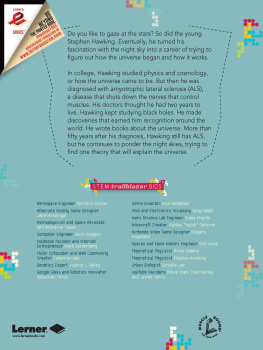
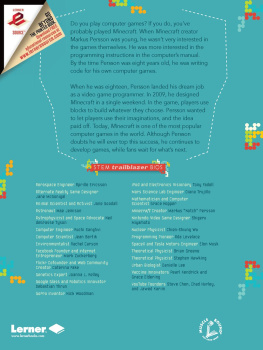
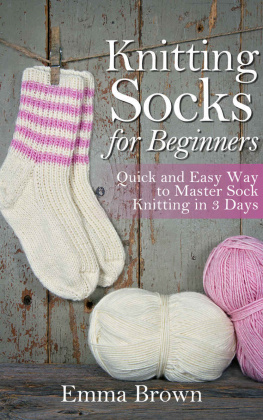
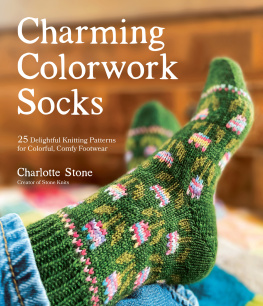
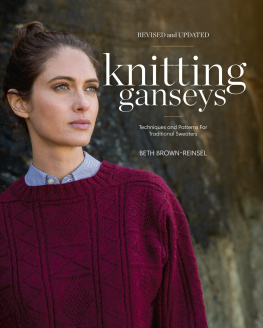
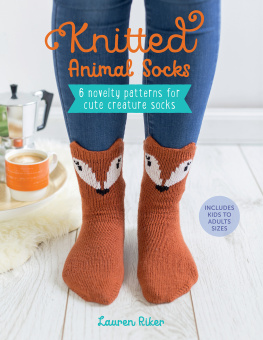


 KNITTING SOCKS
KNITTING SOCKS Kari Cornell, Editor Photography by
Kari Cornell, Editor Photography by First published in 2011 by Voyageur Press, an imprint of MBI Publishing Company, 400 First Avenue North, Suite 300,
First published in 2011 by Voyageur Press, an imprint of MBI Publishing Company, 400 First Avenue North, Suite 300, CONTENTS
CONTENTS 



 INTRODUCTION By Nancy Bush The first item of clothing identified as a sock was made from woven fabric, perhaps fulled, cut, and sewn together into a shape that would roughly fit a foot. Adjustments were made and eventually these items were shaped so that they fit as well as could be expected, considering that the woven material didnt have much stretch.
INTRODUCTION By Nancy Bush The first item of clothing identified as a sock was made from woven fabric, perhaps fulled, cut, and sewn together into a shape that would roughly fit a foot. Adjustments were made and eventually these items were shaped so that they fit as well as could be expected, considering that the woven material didnt have much stretch. A Dutch girl knits socks in this charming vintage postcard. In Viking times (roughly 790 to 1066 AD) and later, even into the twentieth century in some parts of northern Europe, foot coverings resembling socks or stockings were also made using a looping technique known as needle looping or nlbinding in Swedish.
A Dutch girl knits socks in this charming vintage postcard. In Viking times (roughly 790 to 1066 AD) and later, even into the twentieth century in some parts of northern Europe, foot coverings resembling socks or stockings were also made using a looping technique known as needle looping or nlbinding in Swedish.